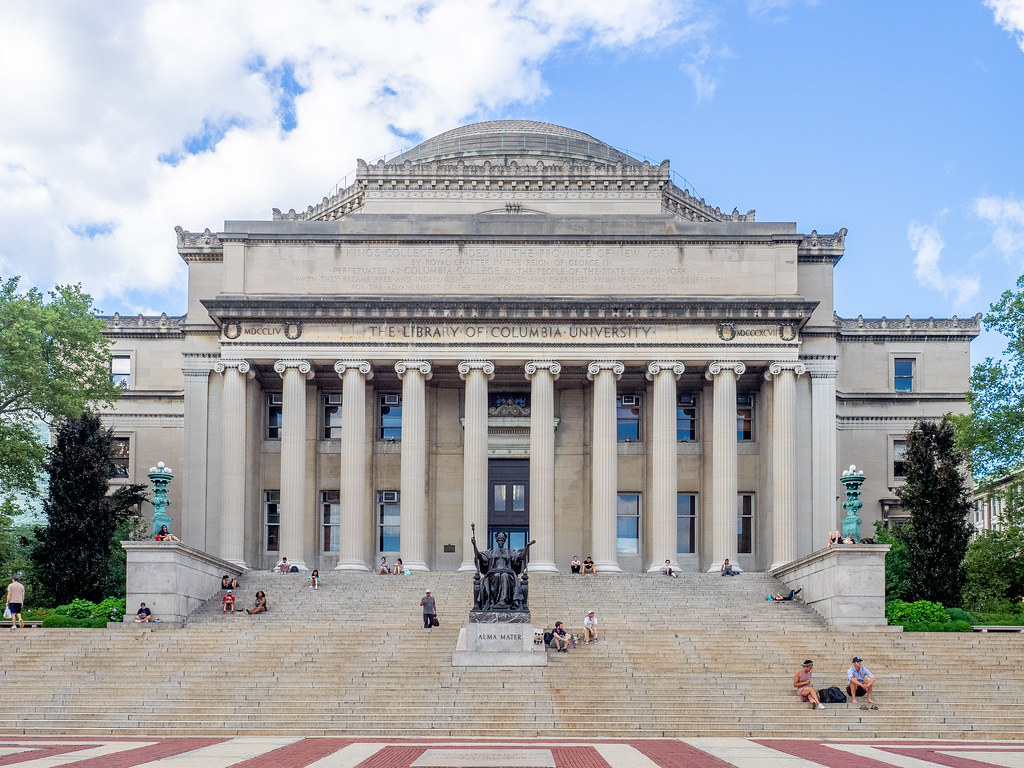
Columbia Acceptance Rate – Introduction
Columbia University, located in New York City, is generally considered one of the best colleges in the United States. As a part of the Ivy League, the Columbia University requirements are stricter than other schools and colleges. Columbia University is currently ranked #18 in National Universities and #5 in Forbes’ Top Colleges List. This means it is a highly competitive option for college-bound students. The Columbia acceptance rate is one of many factors to consider when making your college list. Careful consideration of your admissions odds and other factors will help you decide if Columbia is right for you.
Considering college acceptance rates can help you strategize your college search. With a deeper understanding of the acceptance rate for Columbia, you can make sure all aspects of your Columbia application stand out. Adopting a strong application strategy can help ensure your applications are focused and intentional. While the Columbia acceptance rate may be lower than that of other schools, it should not discourage you from applying.
This article will discuss the Columbia University acceptance rate, along with what it means for students interested in applying. While the Columbia University acceptance rate is low, we’ll discuss ways to strategize your application and college search. We’ll also go over why college acceptance rates matter. We will review admissions trends, and do an in-depth exploration of historical Columbia acceptance rates as well.
What is the Columbia University acceptance rate?
The acceptance rate for Columbia was 3.73% for the class of 2026. During the 2022 admissions cycle, 60,377 students applied to Columbia, and just 2,253 were offered admission. This makes Columbia University one of the more selective school options for students. This is true, even compared with other Ivy League acceptance rates. The Ivy League admissions process can be difficult for students, but understanding the Columbia acceptance rate can help you decide if applying to Columbia is right for you.
The Columbia acceptance rate is so low in part due to the college’s prestige and resources. Columbia boasts a robust research program, as well as numerous notable alumni. Many students are interested in Columbia’s programs of study and faculty, making the Columbia University admissions process extremely competitive.
Columbia University offers over 100 majors and concentrations, as well as its Core Curriculum. The Core Curriculum ensures a well-rounded liberal arts education and allows students to explore a number of different areas of study. This community-focused curriculum contributes to the low Columbia acceptance rate, as intimate class sizes are a key component of the Core Curriculum.
Columbia Acceptance Rate Trends
Across the board, Ivy League acceptance rates have been decreasing in recent years. With increased applications each year, the Columbia University acceptance rate has become more competitive. For the class of 2025, the Columbia acceptance rate was 3.9%, down from 6.1% for the class of 2024. This decrease in the Columbia acceptance rate is primarily due to the increase in applications between 2019 and 2020. It’s hard to predict what the Columbia University acceptance rate will be for the class of 2027, but further a decrease would not be surprising.
Additionally, this past year, the data used to determine Columbia’s ranking was found to be inaccurate. It’s hard to estimate if this will impact the Columbia acceptance rate or the Columbia University admissions process, but this will likely influence Columbia’s ranking in future years.
Test-optional policy
Due to COVID-19, several of the Columbia University requirements were made optional. This may have resulted in an increase in college applications and a sharp decrease in the acceptance rate for Columbia. It’s unclear if Columbia will adopt a permanent test-optional policy or how this may impact the Columbia acceptance rate in the long term. As of now, Columbia has extended the test-optional policy for the next two application cycles.
Columbia enrollment trends are fairly consistent, with between 60-66% of admitted students enrolling each year. A high yield number (the percentage of admitted students who enroll) illustrates that Columbia is an attractive choice for admitted students. While the Columbia University acceptance rate has decreased significantly in recent years, enrollment numbers have remained consistent.
What does the Columbia acceptance rate mean for me?

If you are interested in applying to Columbia, understanding how college acceptance rates work can be crucial to your application strategy. The low Columbia acceptance rate means that all aspects of your application need to be competitive. While the Columbia University admissions office has extended the test-optional policy, submitting stellar SAT and ACT scores can help boost your Columbia application. The average SAT score for Columbia is 1510-1560. You should also aim to keep your GPA as high as you can, as the low Columbia University acceptance rate means most students are at the top of their high school class.
Writing strong supplemental essays can also help increase your chances of Columbia enrollment. The Columbia University requirements for the 2023-2024 application cycle consist of 5 supplemental essays, ranging from 100 to 150 words. While writing this many supplemental essays may seem daunting, these essays will help Columbia University admissions officers understand you better. With such a low college acceptance rate, outstanding supplemental essays may be the key to discovering how to get into Columbia.
Pay attention to application requirements
While the acceptance rate for Columbia may be low, it does not mean you should not apply. If you plan to submit a Columbia application, you should ensure that all aspects of your application align with the Columbia University requirements. In addition to your essays, SAT/ACT scores, and GPA, receiving solid letters of recommendation can also help you compete against the low Columbia acceptance rate.
The Columbia University acceptance rate means that many exceptional students will be unable to gain admission. The Ivy League admissions process can be extremely difficult for students to go through. This is not a reflection on any individual student’s achievements, but rather, an indication of how few available spots exist for incoming students. With small class sizes, Columbia ensures an intimate learning environment and a unique campus experience. While the Columbia acceptance rate means a highly competitive applicant pool, understand that you won’t know your chances of admission until you apply!
What is a good acceptance rate?
A good college acceptance rate is hard to gauge and will depend on many other factors. College acceptance rates are calculated by dividing the number of students accepted by the number of applications a school received. For the 2022 Columbia acceptance rate, as 2,253 students were admitted out of 60,377 applicants (2,253 divided by 60,377, then multiplied by 100 for the percentage), the acceptance rate was 3.73%. This is an exceptionally low college acceptance rate, even compared to other highly competitive schools.
The low acceptance rate for Columbia can imply a certain level of selectivity. However, Ivy League acceptance rates also tend to be low due to smaller class sizes. As of fall 2020, the Columbia enrollment was around 8,100 undergraduate students. With only so many open spots and such high application numbers, Ivy League acceptance rates tend to be the lowest each year.
The Columbia University acceptance rate should not be the only factor you consider when applying. Make sure Columbia has your preferred area of study and offers student organizations that interest you. While the Columbia acceptance rate does indicate prestige, you should focus on whether Columbia is a good fit for your goals. A good acceptance rate is one that you feel reflects your hard work and determination, regardless of if it is considered high or low.
Columbia Acceptance Rates: Early Decision vs. Regular Decision
The Columbia Early Decisions acceptance rate differs from the Regular Decision Columbia acceptance rate every year. The Columbia Early Decisions acceptance rate was 10.31% for the class of 2026. 6,305 students submitted Early Decision applications, and Columbia University offered admission to 650 students. The reason why the Columbia Early Decisions acceptance rate is so different is due to the lower amount of applications submitted through the Early Decision process. So, you may want to consider applying Early Decision if you are passionate about enrolling at Columbia, as the Columbia Early Decisions acceptance rate is a bit higher.
Deciding to apply Early Decision can influence the rest of your college search. Know that applying early is not for everyone. While the Columbia acceptance rate for Regular Decision may intimidate you, make sure you understand the implications of applying Early Decision. Applying early requires you submit your application materials in November. If Columbia admissions accepts you Early Decision, this is a binding commitment. This means Columbia University expects you to enroll if they offer you admission. So, only apply early if you plan to enroll at Columbia and are positive it is your top choice.
Columbia acceptance rate and your College List

When developing your college list, considering the acceptance rate for Columbia is important. Ensuring you have a solid mix of safety, match, and reach schools will provide you with a wide range of options. Generally, safety schools are ones where your GPA (and test scores, if applicable) are higher than the school average. Match schools are schools where your GPA and test scores align with the average undergraduate student. Understanding the difference between your dream school and reach schools will help you decide which schools to focus on. If the Columbia acceptance rate is intimidating, consider similar schools in the area to add to your college list.
Building a college list should help you narrow down your reach schools. Due to the low acceptance rate for Columbia, all students should consider it a reach school. Make sure you balance out your college list with some safety and match schools, where a higher college acceptance rate will help increase your chance of admission. Ivy League admissions are notoriously difficult, but if you have a well-balanced college list, you can be strategic with your Columbia application.
The Columbia University acceptance rate can help you decide how many reach schools you’d like to apply to. There are a number of highly competitive schools, but the low Columbia acceptance rate means that spots at Columbia are some of the rarest in the country. Making sure you don’t have too many reach schools will help increase your chances of gaining admission to a school that aligns with your plans. Having a limited number of reach schools can also help preserve your time and energy for the schools you are passionate about. Just remember, it’s important to make informed decisions regarding your college list so that you get the most out of your applications.
Other Columbia University admissions statistics to consider

In addition to the Columbia acceptance rate, there are a number of other admissions statistics to consider. Despite the low acceptance rate for Columbia, there is a commitment to increasing student body diversity. For the class of 2026, Columbia enrollment increased for students of color, first-generation college students, and Pell-grant-eligible students.
While Columbia has adopted a temporary test-optional policy, it’s helpful to know the average test scores. The average ACT score was 34-35 and the average SAT score was 1520. The average weighted GPA was 4.12, so it’s important to keep your GPA as high as possible if you plan to apply to Columbia. With the Columbia University acceptance rate reflecting a highly competitive applicant pool, it’s crucial for students to utilize all available resources to make their applications stand out. Having a high GPA and test scores can help.
Transfer students
The Columbia University acceptance rate for transfer students differs from the first-year acceptance rate. As with the Columbia Early Decision acceptance rate, the transfer acceptance rate is higher, sitting at 14.7% for the 2022-2023 application cycle. The transfer applicant pool tends to be significantly lower than the first-year pool, resulting in a higher acceptance rate. If the Columbia acceptance rate for first-year students doesn’t work out for you, consider attending a different school and later completing a transfer application.
In addition to the Columbia acceptance rate, financial aid is an important factor to consider as well. For the class of 2026, over half of Columbia’s admitted students received need-based financial aid. Columbia commits to meeting 100% of demonstrated need for all first-year students, making Columbia an excellent financial choice for families.
Columbia Acceptance Rate ‒ Final Thoughts
The Columbia University acceptance rate is one of the lowest in the country. It’s unlikely that the Columbia acceptance rate will rise anytime soon, so it’s important to prepare if you plan to apply to Columbia. First, determine if Columbia fits for you and your academic interests. Research the different academic programs, extracurricular activities, research opportunities, and campus life. Focus your time and energy on your supplemental essays, as these will help paint a holistic picture of who you are and your interest in Columbia. Be strategic around your letters of recommendation, and involve yourself in a wide variety of activities.
Consider applying Early Decision if you are confident that Columbia is your top choice. Applying early can provide peace of mind. Additionally, given the low Columbia acceptance rate, it may be beneficial to apply with a smaller applicant pool.
Above all, don’t let the low Columbia University acceptance rate intimidate you. If you want more information on Columbia University and the application process, check out our webinar with Columbia alumni. You can also review our in-depth guide on how to get into Columbia here. Applying to college can be daunting, but researching your options is the best way to ensure you get the most out of the college admissions process!

This guide to Columbia Acceptance Rate was written by senior advisor, Jess Klein. Looking for more admissions support? Click here to schedule a free meeting with one of our Admissions Specialists. During your meeting, our team will discuss your profile and help you find targeted ways to increase your admissions odds at top schools. We’ll also answer any questions and discuss how CollegeAdvisor.com can support you in the college application process.
